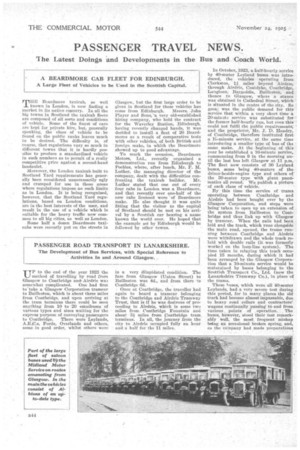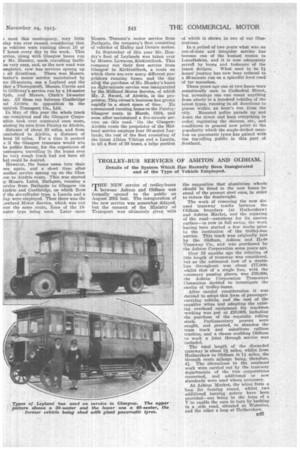PASSENGER ROAD TRANSPORT IN LANARKSHIRE.
Page 28

Page 29

If you've noticed an error in this article please click here to report it so we can fix it.
The Development of Bus Services, with Special Reference to Activities In and Around Glasgow.
TT P to the end of the year 1923 the Ili method of travelling by road from Glasgo* to Coatbridge and, Airdrie was somewhat complicated. One bad first to'take a Glasgow Corporation tramcar to Bailleston, which is about three miles from Coatbridge, and upon arriving at the tram terminus there could be seen anything from 10 to 20 omnibuses of various types and sizes waiting for the express purpose of conveying passengers
to Coatbridge. There were Leylands, A.E.C.s, Fords, Overlands and others, some in good order, whilst others were in a very dilapidated condition. The fare frora Glasgow (Union Street) to Bailleston was 4d., and from there to Coatbridge 43d.
Once at Coatbridge, the traveller had again -to board a tramcar belonging to the Coatbridge and Airdrie Tramway Trust, that is if he was desirous of proceeding to Airdrie, which is some two miles from Coatbridge Fountain and about 34 miles from Coatbridge tram terminus. In all, the journey from the city to Airdrie occupied fully an hour and a half for the 11 miles.
In October, 1923, a half-hourly service by 40-seater Leyland buses was introduced, the vehicles operating from Clarkston, 14 miles beyond Airdrie, through Airdrie, Coatdyke, Coatbridge, Langloan, Bargeddie, Bailleston, and thence to Glasgow, where a stance was obtained in Cathedral Street, which is situated in the centre of the city. So • grea:: was the public demand for this service that within a very short time a 20-minati service was substituted for the form-sr half-hourly run, but even this could not fulfil the public requirements, and the proprietor, Mr. ff. D. Hendry, of Coatbridge, therefore instituted first a 15-minute service, at the same time introducing a smaller type of bus of the same make. At the beginning of this year he established a 10-minute service, commencing from 9 in the morning until the last bus left Glasgow at 11. p.m. The fleet now consists of 30 Leyland buses, some being 40-seaters of the driver-beside-engine type and others of the 30-seater type with giant pnedmaties all round: We publish a picture of each class of vehicle.
By this time the service of trams. operating between Coatbridge and Airdrie had been bought over by the Glasgow Corporation, and steps were being taken to open up an extension of the system from Bailleston to Coatbridge and thus link up with Glasgow by tramcar. When the rails had been laid and the track, which runs alongside the main road, opened, the trains running between Coatbridge and Airdrie were withdrawn and the whole track relaid with double rails (it was formerly worked on the loop-line system). The time taken in relaying this track occupied 15 Months, during which it had been arranged by the Glasgow Corporation that a 10-minute service would be maintained by buses belonging to the Scottish Transport Co., Ltd. (now the Lanarkshire Tramway Co.), in place of the trams.
These hisses, which were all 40-seater Leylands, had a very severe test during this period, for in many places the old• track had become almost impassable, due to heavy road rollers and contractors' wagons continually passing to and from various points of , operation. , The buses, however, stood their test remarkably well, the most frequent mishap being an occasional broken spring, and, as the conipany had made preparations ) meet this "contingency, very little elay was ever caused, considering that ve vehicles were running about 16 or 7 hours every day in the week. This arvice, along with Glasgow buses run F Mr. Hendry, made travelling facili;es very easy, and, as the new road was ompleted, new bus services sprang up 1 all directions. There was Messrs. laxter's motor service maintained by wo 26-seaters, one a Leyland and the ther a Thornycroft, Messrs. Currie and le Gillivray's service run by a 14-seater and IvIeesre. Clark's 14-seater teo. All these ran between Coatbridge nd Airdrie in opposition to the 'cottish Transport Co, Ltd.
In May of this year the whale track_ ras completed and the Glasgow Corpoation took over command once more, muting its cars from Paisley to Airdrie, distance of about 20 miles, and from amiesland to Airdrie, a distance of bout 16 miles. For a time it seemed a if the Glasgow tramcars would win he public favour, for the experience of eissengers travelling in the buses over he very rough track had not been all hat could be desired.
However, the buses came into their .wn again, and a short time after mother service sprang up on the Glas;ow to Airdrie route. This was started iy Messrs. Laird, Barhgate, running a ervice from Bathgate to Glasgow via kirdrie and Coatbridge, on which flees if the six-cylinder type, a Lancia and a 3-uy were employed. Then there was the ..4owland Motor Service, which was run over the same route, Rees of the 14eater type being used. Later came
Messrs. Pennant's motor service from Bathgate, the company's fleet consisting of vehicles of Halley and Dennis makes.
In September of this year Mr. Hendry's fleet of Leylands was taken over by Messrs. Lawsons, Icirkintilloch. This company ran their first service from Glasgow to Kirkintilloch, a route on which there are now many different proprietors running buses, and the day after the purchase of Mr. Hendry's buses an eight-minute service was inaugurated by the Midland Motor Service, of which Mr. J. Sword, of Airdrie, is the proprietor. This owner's business has grown rapidly in a short space of time. He commenced running buses on the PaisleyGlasgow route in March, 1024, and soon after maintained a five-minute service on this road. On the GlasgowAirdrie route the proprietor of the Midland service employs four 30-seater Leylands, the rest of the fleet consisting of the latest Albion Vikings and a Lancia, in all a fleet of 30 buses, a laige portion
of which is shown in one of our illustrations.
In a. period of two years what was an out-of-date and irregular service has become one of the busiest routes in Lanaikshire, and it is now adequately serval by buses and tramcars of the latest designs. What used to be 1* hours' journey has now been reduced to a 30-minute run on a splendid level road of tar macadam.
Three years ago one or two buses were occasionally seen in Cathedral Street, but nowadays one can count anything. from ninety to a hundred vehicles of the latest types, running in all directions to places within an hour's run from the city. Mounted police parade up and down the street and keep everything in order, regulating the stances, etc., and conditions in general now point to the popularity which the single-decked oinnibue on pneumatic tyres has gained with the trevelling public in this part of Scotland.




































